|
< Earlier Kibitzing · PAGE 177 OF 182 ·
Later Kibitzing> |
| Sep-14-13 | | YouRang: <Nickster> When you get a moment...what do you think of black following <31.<Kd1!> f5 32.Kc2 fxe4 33.Rd5 Rf8 34.<c4!> Rf2+ 35.Kc3 Kf7 36.Rxa5 Ke6 37.Ra6+ Kf5 38.<c5!>> with 38...Rf1
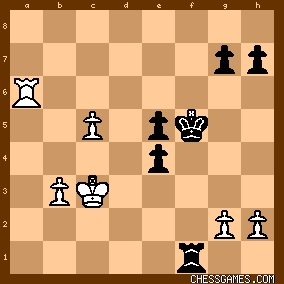
click for larger view
39.? |
|
| Sep-14-13 | | YouRang: <benjinathan: <hms123: I voted <Kd1> with the idea of getting the King to <c2> and the rook to <d5>. This gives us an active rook and a King that is helping on the q-side.>
<hms123> wins the endgame prize!! Sadly, he finishes last in the persuasion sweepstakes....
>
lol :-)
But it's true -- In a team game, finding the right move is only half the battle. The other half is persuading the team to play it. It's a whole different skill set. |
|
| Sep-14-13 | | hms123: <benjinathan>
<Sadly, he finishes last in the persuasion sweepstakes.... > --it's the story of my life. |
|
| Sep-14-13 | | YouRang: <hms123><<Sadly, he finishes last in the persuasion sweepstakes.... > it's the story of my life.>
Phfft. Oh yeah, like, who's going to believe THAT?!
;-) |
|
| Sep-14-13 | | benjinathan: <--it's the story of my life.> But finding Kd1 makes it all worth while- genius! |
|
| Sep-14-13 | | YouRang: <Nickster> Well, I thought 38...Rf1 might work for black, but it's slowing failing -- not a good sign. |
|
| Sep-14-13 | | morfishine: Hello all! My friend <DcGentle> was kind enough to share his analysis of the game showing a White win with <20.O-O> (instead of 20.b3) 1. e4 c5 2. Nf3 Nc6 3. d4 cxd4 4. Nxd4 Nf6 5. Nc3 e5 6. Ndb5
d6 7. Bg5 a6 8. Na3 b5 9. Nd5 Be7 10. Bxf6 Bxf6 11. c3 O-O
12. Nc2 Bg5 13. a4 bxa4 14. Rxa4 a5 15. Bc4 Bd7 16. Nce3
Bxe3 17. Nxe3 Ne7 18. Ra2 Bc6 19. Qd3 Qd7 20. O-O a4 21. f3
Rfd8 22. Rd1 h5 23. Kh1 Qb7 24. Rd2 Qb6 25. Ra1 Qc5 26. Qe2
Rd7 27. Qf2 Rb8 28. Kg1 Kf8 29. Bf1 d5 30. Rad1 a3 31. bxa3
Ba4 32. Re1 dxe4 33. Nc4 e3 34. Qxe3 Qxe3+ 35. Rxe3 Rxd2 36.
Nxd2 f6 37. Re1 Rb2 38. Ne4 Bc6 39. Nc5 Rc2 40. c4 Kf7 41.
Ra1 g5 42. a4 Rd2 43. Ne4 Rb2 44. Nf2 Ke6 45. a5 Nc8 46. Nd3
Rd2 47. Nb4 Na7 48. a6 Kd6 49. Ra2 Rxa2 50. Nxa2 Kc5 51. Kf2
Nc8 52. Bd3 Ne7 53. h3 f5 54. g4 e4 55. fxe4 fxe4 56. Be2
hxg4 57. hxg4 Kd4 58. Nb4 e3+ 59. Kf1 Be4 60. Ke1 Nc8 61.
Kd1 Na7 62. Nc2+ Bxc2+ 63. Kxc2 Nc6 64. Kd1 Ke4 65. Ke1 Na7
66. Bd1 Kd3 67. c5 Ke4 68. Ke2 Kd4 69. Ba4 Kxc5 70. Kxe3 Kb6
71. Ke4 Nc8 72. Kf5 Ne7+ 73. Kxg5
<DcGentle> asked to hold off with direct questions as he's entirely occupied with preparing for the WT game vs Williams <YouRang> I just finished reading all of the posts. Wow, you and <Stunningmove> were monster posters! I found the posts that covered moves 15 - 25 intensely interesting as both sides grappled with the possibilities. <Nickster> I wanted to say it was good working with you directly for the first time. It sounds like you are blaming yourself for not seeing through to a win late in the game. Although it goes without saying, No one person missed anything: we missed it as a team; a pity though, your idea 31.Kd1 was like a shark smelling blood. One can see in the notes, Black was worried about this continuation; In any case, White drifted much earlier in the game ***** |
|
Sep-14-13
 | | OhioChessFan: <benji: But finding Kd1 makes it all worth while> I don't believe you. |
|
| Sep-14-13 | | YouRang: <morfishine> Oh dear, you mean there's *another* way we could have lost? If <DcGentle> is right about 20.O-O, we can probably add 21.O-O to the list too. At least, we thought white should have played that instead of 21.Rd2. Well, let's all learn a lesson from this:
Whenever we have black against a GM, be sure to stay clear of the stinky opening we played in this game! Or as <kwid> put it a couple months ago: <Jul-16-13 kwid: ... Realistically speaking we should be happy to get a draw with our opening which accepts a backward pawn on a half open rook file. Plus a vulnerable single pawn heading into an endgame.> |
|
Sep-14-13
 | | mistermac: So, Nimzovich and the positional school are still valid? It was hard to exploit though as Team White proved. |
|
Sep-14-13
 | | AylerKupp: <morfishine> A 53-move forced sequence from move 20 to move 53, really? Some players will unfortunately occasionally provide long lines with no consideration of alternatives as though all the moves were forced by both sides and declare a "win" for one side or the other. I think that it is fair to say that this is a <possible> win for White after 20.0-0 just like I'm sure there are many <possible> wins for Black after 20.0-0, but that's all I think can be said about this line. For example, after 20.0-0 instead of 20.b3, 21.f3 is probably not needed (at least not immediately) and it does nothing to contest d5. 21.Rfd1 is likely a better move or one that needs to at least be explored before declaring 21.f3 as "the" 21st move. And without 21.f3 then spending another tempo with 23.Kh1 doesn’t seem very useful. And then 28.Kg1? Why would White play 23.Kh1 if he was going to play 28.Kg1 later? The position after 30...a3 sure looks like it's highly advantageous for Black.
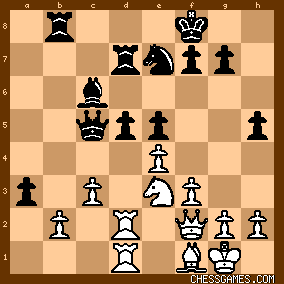
click for larger viewI'm not sure how Black turned such an advantageous position into a loss, since I'm not going to bother to look any further. Maybe after he finishes preparing for the WT game vs. Williams he can address this issue, at least with respect to this analysis. |
|
| Sep-14-13 | | Nickster: <morfishine:<Nickster> I wanted to say it was good working with you directly for the first time. It sounds like you are blaming yourself for not seeing through to a win late in the game. Although it goes without saying, No one person missed anything: we missed it as a team; a pity though, your idea 31.Kd1 was like a shark smelling blood. One can see in the notes, Black was worried about this continuation; In any case, White drifted much earlier in the game> It was great working with you too. You're the type of guy who never gives up. Always searching ... I'm still looking at all the lines so not 100% convinced it's won but yes we should have taken this route. As for white having a win earlier, all I can say is I don't know. I haven't looked. But <AylerKupp> is right. Don't put too much trust in these long variations. If you're going to play in the Williams vs The World game I'll give you a little advice. - Since computer evaluations are allowed get a really strong engine. Stockfish 4 is extremely strong and it's free!! - Use <jepflast> Analysis Tree. It's the best tool we have. - It's not enough to find a great move, you must also 'sell it!' This part I don't like too much. - So many people talking at once. So many variations. Some times one feels like, 'Hey! Is anybody listening to me?' Can be kind of frustrating. It's normal. Don't take it personal. We've all felt like that. - Remember it's just a game. Most are there to pass some time, make friends or just kibitz. Some even sing songs. Great! I used to take these games way too seriously before and have even lost my temper. Silly me. I mellowed out over time. - Someone gets on your nerves just put them on ignore. It's not worth getting stressed over it. It's just a game! - Have fun. There are some really nice people here. |
|
| Sep-14-13 | | Nickster: <YouRang: <Nickster> Well, I thought 38...Rf1 might work for black, but it's slowing failing -- not a good sign.> I've been messing around with this tonight and it's a nice try. 38...Rf1 stops white from playing Ra1. I think 39.Ra2 is the right continuation. Once again I keep seeing black having a hard time holding this game. This is very complex. It's going to take time so sort it all out. I wish I could use <jepflast>'s AT here. :-) |
|
| Sep-14-13 | | YouRang: It's looking like white could have won this game, with 31.Kd1! being a key move. If so, a deeper question is "where did black go wrong?". I'm guessing that it was somewhere in the opening. I always seemed like black was trying to crawl out of a hole. |
|
| Sep-15-13 | | DanLanglois: <Nickster: <YouRang: <Nickster> I'm starting think you're right -- white missed a win!
<31.<Kd1!> f5 32.Kc2 fxe4 33.Rd5 Rf8 34.<c4!> Rf2+ 35.Kc3 Kf7 36.Rxa5 Ke6 37.Ra6+ Kf5 38.<c5!>> The deep engine analysis I've done so far is pointing to a white win. Of course, there's room for doubt that white could have found all these and subsequent key moves without computer assistance. Anyway, on behalf of team Black, I would like the thank team White (and our lucky stars) for <31.Rb2?!> ;-)> So far it looks like a white win. But I still have a lot to check. I have to examine alternatives to <37...Kf5> and <35...Kf7>. I'm working long hours this weekend so not to much analysis. I should have this mapped out by the middle of next week. On a side note Stockfish 4 is impressive.>
38. c5, gives this:
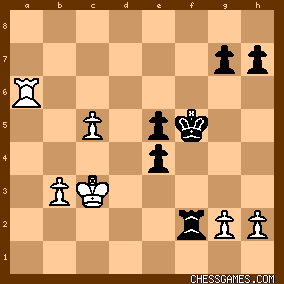
click for larger viewI'm skeptical. But for you <Nickster>, well, naturally I can spare nothing for you, and remain skeptical. |
|
| Sep-15-13 | | DanLanglois: <<YouRang> I see.
34...Rf2+ 35.Kc3 Kf7 36.Rxa5 Ke6 37.Ra6+ Kf5 38.c5 Rxg2 39.Ra1 So far Houdini 3 has this:
Analysis by Houdini 3 Pro w32: depth=28
1. (0.83): 39...Ke6 40.b4 Kd5 41.Rd1+ Kc6 42.Rd6+ Kb7 43.Re6 2. (0.93): 39...Rf2 40.b4 Ke6 41.Ra6+ Kd7 42.b5 Rf3+ 43.Kc4 3. (1.33): 39...e3 40.b4 Ke6 41.b5 e2 42.b6 Kd7 43.Ra7+ Kc8 4. (2.06): 39...Rxh2 40.b4 Rh3+ 41.Kc4 Rd3 42.c6 Ke6 43.b5 Kd6 I've been looking at the main lines which look good for white. I haven't looked at 39...e3 40.b4 e2 yet.> I choose 39...e3. Passed pawn. 40. b4 and you show Black replying 40...Ke6. Now, here is 40. b4 Black to move:
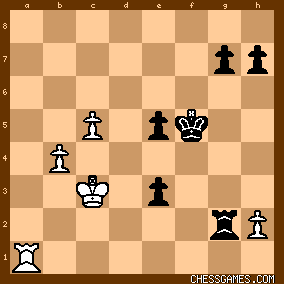
click for larger viewIf we go with 40...Rd2 41. b5 Rd5 42. Kb4 Rd4+
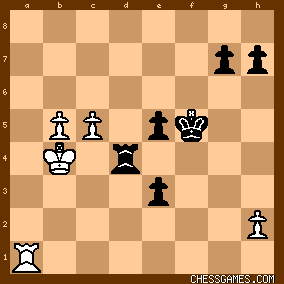
click for larger viewOne sees that 43. Ka5 White has gotten it together with his passed pawn phalanx and advanced king. Could go all the way. White is only to say, not 42...Rd4+. 42...e2, on the other hand, has Black reaching the 7th rank first, how bad can it be? 42...e2

click for larger view43. Rae1 Rd2 44. b6 Ke6

click for larger view45. Kc3 Rd5 46. Kc4 Rd2
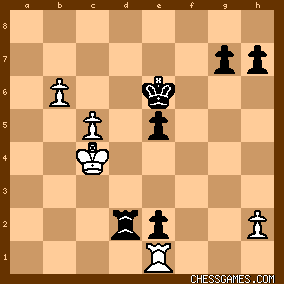
click for larger viewAnd it appears to me, that White is utterly stymied. |
|
| Sep-15-13 | | DanLanglois: Then maybe 46. Rxe2, though it has obvious drawbacks. 46...Rxc5+ 47. Kb4 Rb1 48. Kb5 Kd7 49. Rxe5 Kc8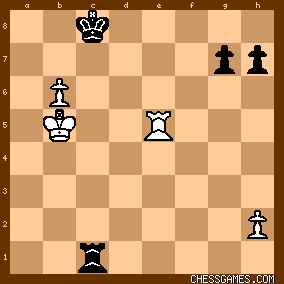
click for larger viewHere, I recollect that White is trying to queen a pawn, nothing less. 50. Re8+ Kb7 51. Re7+ Kc8
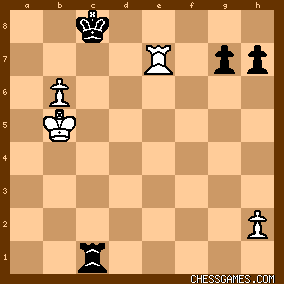
click for larger viewWhat are White's resources? 52. Rxg7 h5 53. Rh7 Rb1+ 54. Kc6 Rc1+ 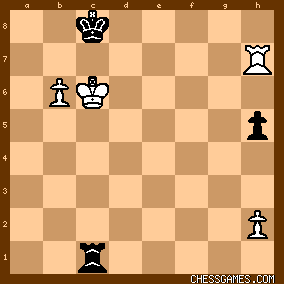
click for larger viewAre we ready to give up on this. Now, I pulled this line, out of offering a Black improvement to your 28ply Houdini3 +1.33 line. This one:
3. (1.33): 39...e3 40.b4 Ke6 41.b5 e2 42.b6 Kd7 43.Ra7+ Kc8 Here, 40...Ke6 is, I take it, absurd. A bug? Anyways, bad. I offered 40...Rd2. Which I have not vetted against Houdini3 28ply. This is 40...Rd2:

click for larger viewThis should, I suppose, be even worse for Black, according to Houdini3 28ply, than +1.33. Now, I see the merit in trying to eyeball a seemingly representative rook endgame. This is seemingly simple stuff. But I'll fish for a Houdini eval..how about if I settle for 23ply, as just some blunder-checking due diligence. Naturally, 24ply might change the picture, etc. I'm letting WhiteHoudini produce a 41st move, here, at 23ply. Meantime I muse on the fact the Black is rook on 7th, Black has the more advanced passed pawn. I don't have the patience, but what about 41. Re1 Ke4 42. c6 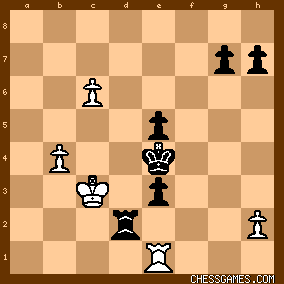
click for larger viewBut given that Black has 42...Rd3+, here, I suppose that White is pretty well out of ideas. I do have my 23ply 41st move for WhiteHoudini--I have 41. b5, which I already posted about above. It's offered up as +0.34, which seems manageable, as above. Finding the win, here, is like, to quote Scarlett Johansson (long story), it's like finding a needle in the Chrystler Building. Have you got anything? Besides, your assessments of who is counterproductive? |
|
| Sep-15-13 | | DanLanglois: In point of fact, that diagram ('I suppose that White is pretty well out of ideas') is a forced win for White, and I might describe this as illustrating genuine winning *chances*, w/out feeling a great need to resolve the ambiguity. |
|
| Sep-15-13 | | stunningmove: <DL> A lot of what you are looking at were the original lines that <YouRang> and I analyzed. I threw a lot of lines away after they moved Rb2 but here is what I saved. One thing we became aware of right away is that the g and h pawns are probably poison and moving Rd2 for black is necessary. This was all done without computers so errors may exist. Of course, computers make silly moves as well. I would assume they would take the white g pawn if given the choice. And sure enough it did. Try this without the computer suggestion of Rxg2. 31. Kd1 f5 32. Kc2 fxe4 33. Rd5 Rf8 34. c4! Rf2+ 35. Kc3 Kf7 36. Rxa5 Ke6 37. b4 e3! 
click for larger view 38. Ra6+
(38. b5 Rxg2 39. Kd3 e2 40. Kd2
e1=Q+ 41. Kxe1 Rxh2 42. Ra6+ Kd7 43. c5 Rb2 44. c6+ Kd6) 
click for larger view 38. .. Kf5 39. c5 Rd2 (notice how that at this point black is 2 tempi ahead of your version because he didn't take the g pawn.) 
click for larger view 40. Ra1
(40. c6 Ke6 41. b5 Kd6 42. Ra1 Rd5 43. Kb4 e2 44. Re1 Rd2 45.Kc3 Rd5 ½) 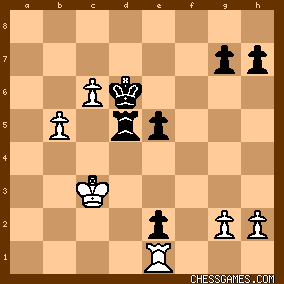
click for larger view 40. .. Ke4! 41. c6 Rd3+ 42. Kc4 Rd2 43. Kb5 Rc2 44. Kb6 Kd5 45.Rd1+ Ke6 46. Re1 Kd6 47. b5 e2 48. Kb7 e4 
click for larger view 49. b6 Rxc6 50. Rxe2 Rc4 I quickly ran my Houdini 1.5 over this and it all seemed to work at 26 ply. If you are so motivated you might find something that <YouRang> and I missed let me know. I still see it as a draw, by the skin of our teeth. |
|
| Sep-15-13 | | DanLanglois: nope, 'you're improving for White'
<31.<Kd1!> f5 32.Kc2 fxe4 33.Rd5 Rf8 34.<c4!> Rf2+ 35.Kc3 Kf7 36.Rxa5 Ke6 37.Ra6+ Kf5 38.<c5!>> Here, we see 37. Ra6+ & etc. |
|
| Sep-15-13 | | stunningmove: What's the rest of the line? Doesn't it transpose? Be sure to not allow Rxg2 for black. Please help I'm not seeing the winning kune |
|
| Sep-15-13 | | morfishine: <AylerKupp> You are right about the "53-move forced sequence". Keep in mind <DcGentle>'s style of posting lines through to mate. In his line <20.O-O> White is up a pawn by move 31 and White has a significant advantage by move 40. So what’s critical here is the 21-move sequence (from moves 20-40) with clearly one point of discussion being <30…a3>. From an assessment perspective, and I’m trying to get better at this, there’s little difference eval-wise between 20.O-O and what we played 20.b3. I’d say 20.O-O would have been simpler or easier to play [ie: 20.b3 combined with keeping our King in the center is somewhat trickier]. One things for sure, our “opening team” was fantastic. <cro777>, <capafan> & <Pedro Fernandez> and yourself set the table perfectly and more than neutralized any supposed “strength advantage” on the Black side |
|
| Sep-15-13 | | DanLanglois: I've rested my case at: 'I might describe this as illustrating genuine winning *chances*, w/out feeling a great need to resolve the ambiguity.' |
|
| Sep-15-13 | | morfishine: <YouRang><Danlanglois><Stunningmove> Your posts on <31.Kd1> are highly interesting. But if one wants to get to the heart of the game as quickly as possible, doesn’t it make sense to start the analysis earlier? For example, if its shown that 31.Kd1 wins, then that necessitates going back to find where Black erred. Faster would be to start from a position where White has an advantage, then work both ways looking (1) forward where White possibly slipped and (2) backwards to where Black may have played a less than accurate move contributing to White’s initial advantage. Narrowing it down this way is quicker and more efficient. IMO, the best process would be first to check variations vs the accepted opening (I’m referencing MCO 2011). This game was book through move 14 with no meaningful variations for White and only two for Black (9…Qa5+ & 12…Rb8). We can throw out the first 14 moves. IMO, White is gaining a pull by move 17 and has an advantage after 19…Qd7 due to Black’s backward d-pawn and isolated a-pawn. (Advantage being defined here as Black having zero winning chances: Only White can win). So, the logical place to start to get to the heart of this game is between moves 15 – 19. Furthermore, somewhere between moves 20 – 30 (or so), White’s winning chances in turn dropped to zero. IMHO, identify the moves that define these two critical points (1) Only White can win, but this changes to (2) Neither side can win, and you’ve found the secrets to this game ***** |
|
| Sep-15-13 | | YouRang: <DanLanglois>: <<34...Rf2+ 35.Kc3 Kf7 36.Rxa5 Ke6 37.Ra6+ Kf5 38.c5 Rxg2 39.Ra1> I choose 39...e3. Passed pawn.
40. b4 and you show Black replying 40...Ke6. Now, here is 40. b4 Black to move: If we go with 40...Rd2 41. b5 Rd5 42. Kb4 Rd4+ > <DanLanglois>: <<34...Rf2+ 35.Kc3 Kf7 36.Rxa5 Ke6 37.Ra6+ Kf5 38.c5 Rxg2 39.Ra1>I choose 39...e3. Passed pawn.
40. b4 and you show Black replying 40...Ke6. Now, here is 40. b4 Black to move: If we go with 40...Rd2 41. b5 Rd5 42. Kb4 Rd4+ > Instead of 41.b5 for white, how about <41.Re1>?
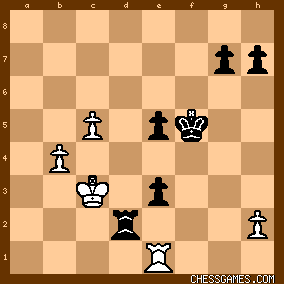
click for larger view
It creates a bit of a dilemma for black. Guard Pe3? Retreat to e6? Still try Rd5? |
|
 |
 |
|
< Earlier Kibitzing · PAGE 177 OF 182 ·
Later Kibitzing> |
|
|
|






